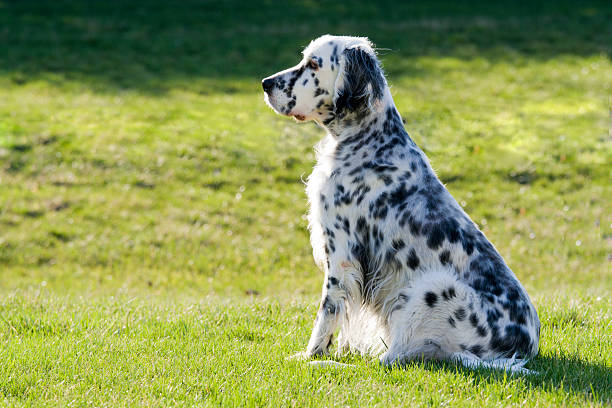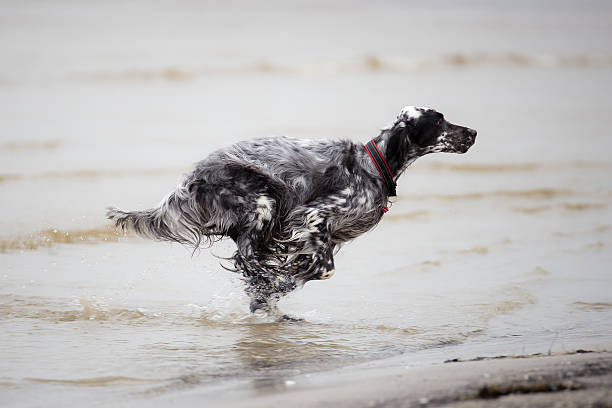English Setter

Breed History:
The English Setter is one of the oldest gun dog breeds, with roots tracing back to the 16th century in England. It was developed from crosses of Spanish Pointers, large Water Spaniels, and early land Spaniels to create a skilled bird dog that could locate game birds and “set” or crouch low to signal their presence.
Refined in the 19th century by breeders like Edward Laverack and R. Purcell Llewellin, the English Setter developed into two strains: one for conformation (Laverack type) and one for field work (Llewellin type). Both types retain the breed’s hallmark grace, endurance, and soft temperament.
English Setters have long been admired for their elegant looks and ability in the field. They’ve earned a place in hunting, shows, and family life across Europe and North America.
|
Gender |
Height |
Weight |
|
Male |
65-70 cm |
27-36 kg |
|
Female |
60-65 cm |
20-32 kg |
Size – Medium-Large
Life Expectancy: 10–12 years

Breed Appearance:
The English Setter is a graceful, athletic dog with a moderately long, silky coat and a distinctive feathered appearance on the ears, chest, legs, and tail. The head is long and refined with expressive, hazel to dark brown eyes and low-set, long ears.
Its coat features a pattern called "belton"—a base of white with intermingled colored specks. Accepted colors include:
-
Blue Belton (black and white)
-
Orange Belton
-
Lemon Belton
-
Liver Belton
-
Tricolor (blue belton with tan markings)
They have a smooth, elegant gait and are often described as one of the most beautiful of all gundogs.
Breed Type – Sporting/Companion:
Bred as a bird-setting dog, the English Setter is a gentle, friendly, and sociable breed that thrives both as a field companion and a family pet. It is affectionate, sensitive, and devoted, often seeking constant contact with its humans.
While they retain strong hunting instincts, they are less hyper than other sporting breeds and generally do well in active family homes. Their friendly nature makes them poor guard dogs, but excellent with children and other dogs.

Training:
English Setters are intelligent but sensitive, and respond best to positive reinforcement and patience. Harsh corrections can damage their trust. They are eager to please and enjoy learning in short, consistent sessions.
Early socialization and basic obedience are key to managing their natural independence and prey drive. Their keen noses and endurance also make them suitable for tracking, agility, and field trials.
Health & Care:
Generally healthy, English Setters can be prone to:
-
Hip dysplasia
-
Elbow dysplasia
-
Hypothyroidism
-
Deafness (especially in dogs with predominantly white coloring)
-
Progressive retinal atrophy (PRA)
Routine vet checkups, health screenings, and maintaining a healthy weight help prevent joint stress. Reputable breeders test for hereditary diseases.

Living Conditions:
English Setters are adaptable but thrive in homes with access to outdoor space. They can live in apartments only if given adequate daily exercise and mental stimulation.
This breed does not tolerate long periods of isolation and may become vocal or destructive if bored. They prefer environments where they can run, explore, and interact with people regularly.
Exercise:
These are active, energetic dogs that need at least 1–2 hours of daily exercise, including free running in safe spaces, structured games, and mental enrichment. They excel in dog sports, hiking, and fieldwork.
Without enough exercise, English Setters may develop behavioral issues such as digging, barking, or restlessness.
Grooming:
The long, feathered coat requires regular upkeep to prevent matting:
-
Brushing 2–3 times per week
-
Bathing every 4–6 weeks
-
Trim feathering as needed to maintain neatness
Pay attention to ear hygiene, as their long ears can trap moisture and cause infections. Also maintain dental care and nail trimming.
They are moderate shedders, more so during seasonal changes.

Advantages:
-
Gentle and affectionate with children and family
-
Beautiful, distinctive coat and elegant build
-
Friendly and social with other dogs
-
Versatile in the field and in dog sports
-
Adaptable to many living situations with proper exercise
-
Strong hunting instincts paired with a sweet temperament
Disadvantages:
-
Needs significant daily exercise and mental engagement
-
Coat requires regular grooming and maintenance
-
Can be prone to separation anxiety and vocalizing
-
Not ideal as a guard dog—too friendly
-
May chase small animals due to strong prey drive
-
Sensitive to harsh training methods

